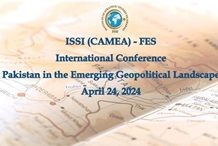The foundation-stone of an industrial revolution has been laid down in Pakistan. The all-weather cordiale entente is on the ever-expanding path. Pakistan has been blessed with an epic investment of over US$ billion 46 offered by China to build multiple projects covering 51 agreements under the China Pakistan Economic Corridor (CPEC). The ground-breaking ceremony kick started for US$ 28 billion advance projects is expected to be completed by 2018.
The offer was unveiled after President Xi Jinping visited Pakistan on 20-21 April; his first-ever visit to Pakistan after becoming President in 2013. Both countries are regarded as each other’s ‘iron brothers.’
The infrastructure of many Asian countries is out dated. It needs new funds to be injected. Asian infrastructure needs at least US$ 720 billion annually. For this purpose, China has launched the Asia Infrastructure & Investment Bank (AIIB) last October with an initial equity of US$ 50, which was joined by a number of Asian countries to offer funds to build infrastructure in Asia. Many European countries have also joined the bank. Japan has been considering joining the AIIB.
There is no reason why the United States has been staying out from the AIIB and criticizing it. The action has isolated the United States. Pakistan is the founding-member of the AIIB.
Now, China has become a powerful factor in expanding Pakistan’s economy in the 21 century under China’s’ “One Belt One Road” policy to connect China with several regions of the Asian Continent. Xinjiang will be connected with the deep sea Gwadar Port in the Arabian Sea. Besides Pakistan, Xinjiang will be connected with Central Asian Republics. China Yunnan province will be connected with Myanmar, Bangladesh, and India.
China has constructed the Hambantota port in Sri Lanka and is developing a number of seaports in Myanmar after upgrading the Chittagong port in Bangladesh. So China is vigorously concentrating on Asia’s road connectivity and seaports’ development for commercial purposes with no strings attached to military build-up as was propagated in Western and Indian media.
Linking up Gwader with Kashghar in western China is the dream of the 21 century. A road and railway track along with energy pipeline and industrial towns and an optic fiber line will be laid down to connect both regions for trade, commerce, and tourism purposes. This will be the longest land corridor ever built in human history, exceeding 2,500 to 3,000 km.
China has already promised to offer US 2 billion to build Pakistan’s portion of its gas pipeline with Iran, an indication of China’s firm resolve to build energy pipelines and infrastructure in Asia.
President Xi’s address to Pakistan’s Parliamentary joint session was the first-ever by a Chinese dignitary and the first by any foreign leader to the present Parliament. Earlier, four Chinese leaders addressed the Parliament, a credit never taken by any other country.
President Xi paid tributes to Pakistan providing air access to China when the country was isolated. Pakistan was the first Islamic country to recognize China in 1950. He also paid tributes to the poet-philosopher Allama Iqbal who in his poetry appreciated the Chinese struggle and predicted in 1930 that China would emerge as a great country. He lauded Prime Minister Sharif’s vision to elevate Pakistan to the level of an ‘Asian tiger economy’ and this is indeed an opportunity for Pakistan to become an ‘Asian tiger’.
Pakistan and China were not significant trading partners in the past. However, on trade and investment fronts, they have crossed many barriers now. Trade has increased to US$ 16 billion now after the operationalization of the Free Trade Agreement (FTA) in January 2007 when bilateral trade stood around US$ 7.5 billion. Bottlenecks still surrounding FTA need to be removed and making Pakistani products in the Chinese market more competitive and attractive.
Bilateral trade was less than US$ 1 billion in 2001 and less than US$ half billion in 1991 respectively. Moreover, bilateral trade did not witness any significant progress during 1981-91 and stood around US$ half a billion. When relations were put on more robust growth in the early in 1970s, bilateral trade was recorded only US$ 54 million.
Interestingly, both countries’ traded goods were worth only US$ 14 million in 1961. Today, in Pakistan’s total global trade, China occupies a 22 percent share.
Similarly, China did not play a significant role in investing its capital in Pakistan in the past. Chinese private firms started investing in Pakistan by 1997 under its trade and investment liberalization policy and brought rather a small capital into Pakistani investment market compared to the United States and European countries in the 1990s.
It was in 2007 that China invested US$ 712 million by becoming the fourth largest investor in Pakistan but again its investment could not sustain and declined which comeback to US$ 700.3 million in 2014, by making it the largest investor in Pakistan. It is expected that this trend would continue and major breakthrough could happen in trade and investment.
President Xi’s visit hailed a historic development opportunity for the ailing Pakistani economy, which has been showing a positive outlook now. China wants to bump up the security of Pakistan by elevating it to the level of an Asian tiger economy.
Views expressed are of the author and do not necessarily reflect the views of ISS or of the Government of Pakistan.












